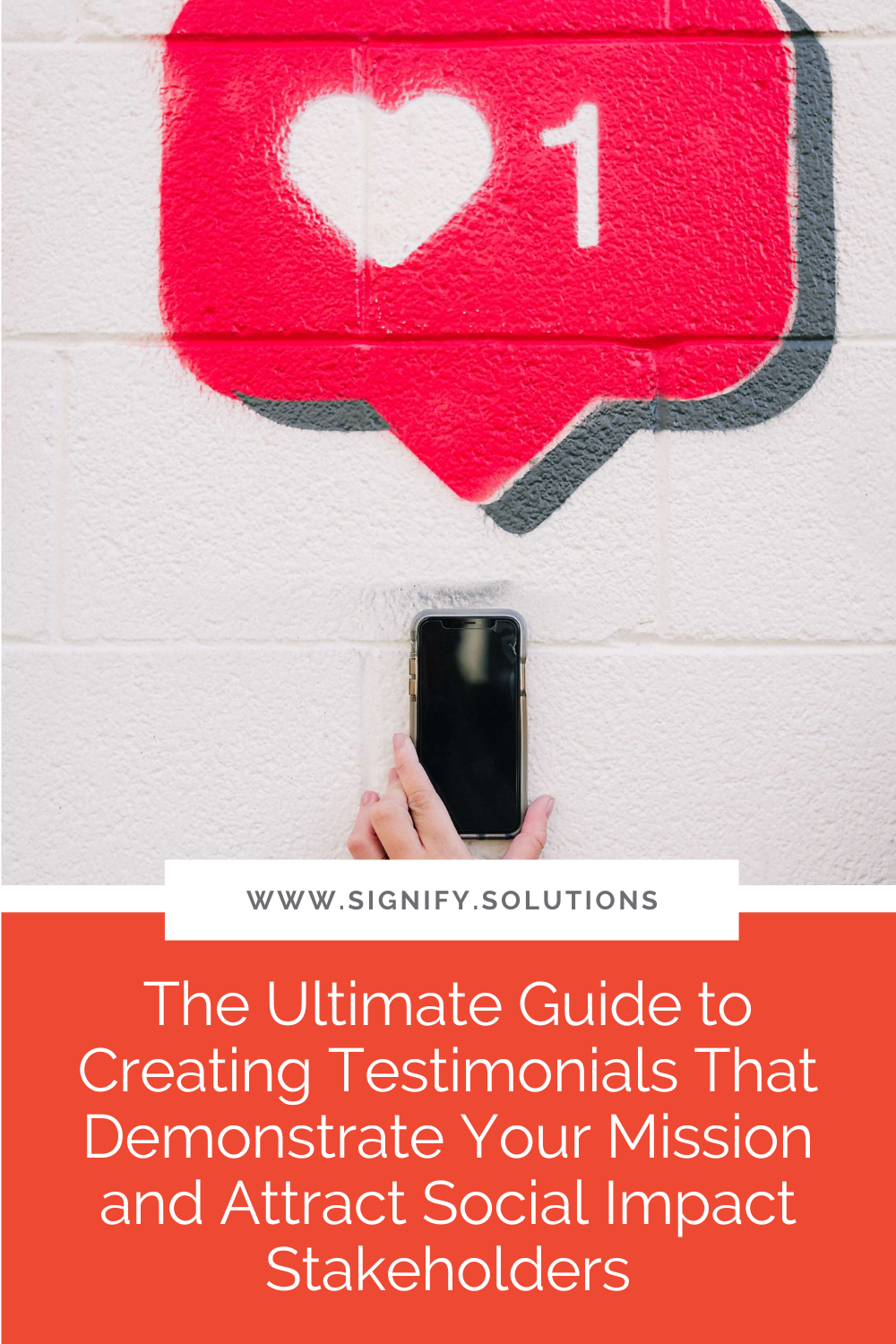Success is a word heavy with implications. It means something different to each person and each organization. It’s relative; success for one could look like reaching a million followers on a social media platform, while to another it could be finally hitting a high donation goal or meeting someone with needed resources.
Success could be a number, a feeling, a noticed impact, or influence. Whatever it looks like to you, big or small, we can all agree that success is something we strive for in creating impact. And just as there is no one correct answer for what success is, there’s no one way to achieve it.
In my opinion, success is anything that leads to a meaningful win for your organization. As a nonprofit leader, the road to success can often look longer and steeper than most. Creating lasting impact and changing the world for the better will do that! Your efforts are needed and important, but it can be challenging to know what to do to get yourself where you want to be and achieve the success you envision.
I spoke with a few nonprofit leaders who I admire about what success means to them, what helped them achieve it—and where it led. Their feedback was unsurprisingly invaluable and inspiring, so read on to learn what these nonprofit leaders said were their secrets to success.
Irene Barton - Cobb Collaborative
Cobb Collaborative educates, engages, and empowers local people and organizations to improve outcomes for children and families in Cobb County, Georgia.
What helped you achieve success?
Networking in the community - not just with other nonprofits, but also with funders, businesses, government agencies, and community members.
What success did it lead to?
I ended up being part of the conversation to address issues that aligned with our initiatives. The one initiative area where we really saw growth was mental health. It was a critical issue before the pandemic and now has really been heightened. Because I went to meetings, gatherings, and workshops hosted by a variety of leaders - public health, state agencies, K-12 educators, social services - and could bring information about what we were doing and how we could help address the problem, more opportunities kept popping up. It became, “Have you heard that the Cobb Collaborative is doing a lot around mental health” and, “You might want to reach out and see if the Collaborative has any ideas or resources around that issue.” That led to connections, being at the table, and ultimately - financial investment.
What is your advice for others to achieve similar success?
Much like for-profit business owners, there is a difference between working "on" your business versus "in" your business. My advice is to get connected with others - subject matter experts, thought leaders, peers, and community leaders. You might go to a few meetings where you emerge without a specific connection, but sooner or later, you will build enough of a network that opportunities to grow your organization will start to emerge.
Jeff Shaw - Frontline Response
Frontline Response is on the frontlines every day rescuing individuals out of the darkness of sex trafficking and homelessness while preventing children and other vulnerable individuals from falling victim.
What helped you achieve success?
We have recently undergone a shift from focusing on outputs to focusing on outcomes. Rather than measuring what we do or how many people we do it for, we're looking at how what we do moves the needle in the lives of the people we're doing it for. Being able to take an honest look at impact allows us to better invite partners and donors into the story, evaluate our programs and their effectiveness, and test new things.
What success did it lead to?
We have only just begun, but by next year we'll be able to look at a year's worth of initial outcomes and begin the process of evaluating and updating our programs and services to be most effective. Additionally, we're already seeing the increase in confidence and support from our partners!
What is your advice for others to achieve similar success?
First, bring in someone who understands outcomes and logic models to teach you and to facilitate the process of determining your outcomes. Second, be sure to teach your team about outcomes and bring them on the journey with you. This is a cultural shift and it's important for everyone to be bought in! Lastly, identify a platform that can help you manage your data and monitor outcomes. We went with SureImpact. So far, so good!
Kayla Stagnaro - Plywood People
Plywood People is a nonprofit in Atlanta leading a community of startups doing good.
What helped you achieve success?
Time blocking
What success did it lead to?
Time blocking allows me to get things done more efficiently. It also helps me set boundaries, so I can make sure to prioritize the work I need to get done.
What is your advice for others to achieve similar success?
If you haven't tried time blocking before, I recommend picking one or two tasks to time block for the next two weeks. For example, try blocking off time when you answer emails, so it doesn't consume every down minute (30 minutes in the morning and 30 minutes in the afternoon). After that two weeks, evaluate what worked and what didn't.
Rima Patel - Center for Financial Inclusion at Accion
Center for Financial Inclusion at Accion is a global nonprofit committed to creating a financially inclusive world, with a trailblazing legacy in microfinance and fintech impact investing.
What helped you achieve success?
Building a strong brand and getting the entire team on the same page. A brand can't reach its potential unless the team behind it internalizes the brand values, represents the mission, and understands what makes them unique. If these are not clear to your team, it's probably not clear to anyone else.
What success did it lead to?
Aligning our team and brand has led to a more intentional communications approach, forced us to consider critical questions about our organization, including how we are keeping up with industry trends, and helps us deliver our message to potential partners and donors more succinctly and eloquently. We already knew who we were, but now we can talk about it to others in a consistent way.
What is your advice for others to achieve similar success?
Taking the time to sit down, brainstorm, and have the hard conversations (because there will always be disagreements) will align everyone, their work, and how your organization positions itself to the world. If these internal processes and perspectives are aligned, your brand values and attributes will be better represented to everyone else.
Rebecca Rothney - Pack for a Purpose
Pack for a Purpose positively impacts communities around the world by assisting travelers who want to take meaningful contributions to the destinations they visit.
What helped you achieve success?
My success was achieved with the talents of my incredible friends, their willingness to donate their time and skills, and their belief in the mission. This, of course, was ensured by providing them with my hot, out-of-the-oven, homemade, mint chocolate chip cookies. In addition, we have many outstanding universities in the area, which have been a source of excellent interns.
What success did it lead to?
Our success has allowed us to grow in the last 14 years from 29 participants (accommodations and tour companies) in 15 countries to more than 400 participants in over 50 countries. Each one of these participants supports local community projects that enhance the welfare of the community.
What is your advice for others to achieve similar success?
Know how to bake a great cookie! Have generous and talented friends. Be persistent. If someone answers no, ask someone else until you find the person willing to say yes. Work as a meritocracy. The best ideas, no matter the source, are the ones that will lead to success.
Derreck Kayongo - Africa Mbele
Africa Mbele is a movement that aims to educate, mobilize and activate the Diaspora community in order to end extreme corruption in Africa.
What helped you achieve success?
"Investors" are people who participated in my formation from the day I was born to the day I built my first company. They include my parents, a missionary woman from Pittsburgh who helped raise me, a believing investor who donated money for me to go to college in Boston, an excellent formal VP at Hilton hotels who joined my board at my company and helped me get $1.3 million from Hilton to build my first factory, and the hotel industry that believed in my idea to recycle and repurpose partially used soap from the hotels. Without these investors and more, I would have never been successful!
What success did it lead to?
My organization was then able to provide soap to people all over the world that faced natural and human-made disasters. For example, the Haiti earthquake and the Ebola epidemic in Liberia. But perhaps an even better outcome is that because of our work at the Global Soap Project, the hotel industry has responded to the waste by mounting liquid canisters in bathrooms. I'm proud of that shift and that is my legacy.
What is your advice for others to achieve similar success?
Don't wait for all the ducks to be in a row. Start and learn the art of improvising along the way, because if Mike Tyson taught us anything, it was that everyone has a plan until they are punched in the face, then everything goes out the window. Plans are good, but improvising with cleverness is even better.
Ashley Jones - Love Not Lost
Love Not Lost is on a mission to revolutionize the way we heal in grief. They photograph people facing a terminal diagnosis to celebrate life and preserve memories together with their families and those they love.
What helped you achieve success?
As I was learning how to run a business over a decade ago, I kept hearing mentors say the phrase, “innovate or die.” It’s been some of the best advice that I have taken with me as I have started a nonprofit, too. The reminder of death in the business sense keeps me from getting complacent, and actually in life too.
It’s kind of ironic that the nonprofit I started is focused on helping people with death and healing. Keeping the end in mind can be so inspiring and fuel creativity as well. Why go through life being bored?!
What success did it lead to?
It’s led me to create fun and successful events - our most recent one coming up is our UN-gala with another new concept in the works for this fall/winter.
What is your advice for others to achieve similar success?
Take the same advice I did: Innovate or die.
Luiza Raposo - The Georgia Center for Nonprofits
The Georgia Center for Nonprofits is Georgia’s largest association of nonprofits. A hub for social innovation, GCN creates thriving communities by helping nonprofits succeed.
What helped you achieve success?
Not trying to do everything for everyone but being strategic about goals, which helped clarify what to focus on.
What success did it lead to?
Each year on Giving Tuesday, GA Gives raises millions of dollars for Georgia nonprofits and raises awareness of the sector.
What is your advice for others to achieve similar success?
Don't skip planning and go straight into tactics/executions.
Emily Laney - Girl Talk, Inc.
Girl Talk inspires all girls to be confident leaders through peer-to-peer mentoring programs.
What helped you achieve success?
Building relationships has led me to success at Girl Talk. Two examples come to mind. One, I applied to join a nonprofit leadership program through Chick-fil-A and Plywood People. Being accepted to that program gave me an instant community of fellow nonprofit leaders. Their expertise and support has meant so much. Additionally, the connection with Plywood People has led to operational success for Girl Talk, as we learned about the opportunity to become Plywood Place members, saving us money each month on office space and giving us more opportunities for networking.
Secondly, I have tried to be brave and reach out to people on LinkedIn, asking to connect to get their advice or talk about our organization. I've been honest and reciprocal in those conversations, which has led to event sponsorships, board members, and new relationships. It's been amazing to see how willing people are to grab a cup of coffee and chat.
What success did it lead to?
It's led to more relationships, cost saving, sponsorships, and increased fundraising revenue.
What is your advice for others to achieve similar success?
Do not be afraid to ask someone to connect. Most people are happy to grab a cup of coffee and chat. Be clear in your intentions but focus on relationship building. Have an agenda in mind and talking points but allow the conversation to flow and be natural. And try to not make conversations one-sided—ask if you can help that person with anything or make connections for them as well.
Simon Doble - SolarBuddy
SolarBuddy is an impact organization uniting a global community to illuminate the futures of all children by gifting solar lights to children living in energy poverty.
What helped you achieve success?
Perseverance, persistence, passion, purpose.
What success did it lead to?
We had triple digit year-on-year growth in our first four years, and we were operational in 54 countries within six years.
What is your advice for others to achieve similar success?
You really do have to love what you do to keep going through all the adversity and challenges, and do it all for the right reasons that are true to your ethics and morals. Otherwise, don't bother.
Whether it’s networking to form new relationships with investors, donors, or supporters, time blocking to achieve tasks, or building a strong brand with your team to get clear on your mission and communicate it to the world, all of this advice can help your organization make a bigger impact. How can you incorporate these tips into your success plan?
PIN THIS POST FOR LATER:
I'm Kristi Porter, and I started Signify to help small nonprofits and for-profits with a social mission get noticed and grow through effective marketing and communications. I also teach solopreneurs and small businesses how to incorporate philanthropy and giving strategies. I believe that cause-focused organizations like yours are the future of business. You're proof that companies can both make money and do good. And I'm here to make sure you focus and shine. When you succeed, we all win.






































